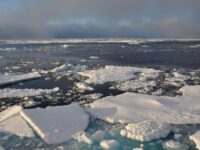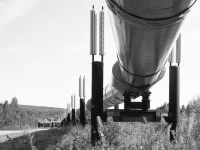In 2014, the United Nations Intergovernmental Panel on Climate Change, the world’s leading voice on the matter, released its latest assessment report, delivering stunning predictions of the potential consequences of human-driven climate change in the 21st century. At the same time that the U.N. panel in Geneva prepared the report for release, an international team of climate and ocean scientists left port — headed for Alaska. They hoped to uncover one of the greatest missing pieces in scientists’ understanding of past climate change: what had happened in the North Pacific directly after the last ice age from 9,000 to 19,000 years ago. The expedition lasted two months, during which the team traveled to five sites to drill sediment cores, which act as geological time capsules, storing information in their chemical make-up. Climate expert and Northeastern professor Dr. Daniel Douglass elaborates, “The transition out of the last ice age is a good chance to study how changes occur.” Furthermore, comparing these results against current climate models, Douglass says, “is the best way to find and correct any mistakes that may exist in the models and gives us more confidence in the accuracy of their predictions going forward.”
The expedition lasted two months, during which the team traveled to five sites to drill sediment cores, which act as geological time capsules, storing information in their chemical make-up.
In 2020, the analysis of the North Pacific core samples is finally reaching completion in the form of a detailed string of scientific papers. Dr. Alan C. Mix, a climate and ocean researcher at Oregon State University and member of the expedition team explains, “Each paper builds on the previous one, such that the puzzle picture is starting to emerge, and it appears to be pretty important as one of the ‘missing links’ in global climate evolution.”
One of the first pieces of the puzzle was published in 2015 by Dr. Summer Praetorius, a former student of Mix. The paper made headlines announcing a link between abrupt ocean warming and expansive oxygen-deficient regions, coined “dead zones” because of their inhospitableness to life. Praetorius postulated that hotter water, which cannot hold as much dissolved oxygen as cooler water, accelerates the chemical processes undertaken by small marine lifeforms, like plankton. These processes further remove oxygen from the water by packaging it with organic material, creating a runaway feedback loop in which a small amount of ocean warming in a region can cause a significant depletion of oxygen. The paper warns that ocean temperatures in this century are likely to increase at a rate beyond anything measured in the past, and the consequences for marine life, as well as human fisheries, could be catastrophic.
The paper warns that ocean temperatures in this century are likely to increase at a rate beyond anything measured in the past, and the consequences for marine life, as well as human fisheries, could be catastrophic.
Another former student of Mix, Dr. Jianghui Du, utilized the expedition’s data to add another piece to the puzzle in a 2018 paper, linking the release of carbon dioxide into the atmosphere to the strength of ocean circulation. Through computer modeling and simulation, Du determined that ocean currents pulled from a massive carbon dioxide reservoir sitting at the bottom of the Pacific and circulated it to the surface, releasing the carbon dioxide into the atmosphere. The model also showed melting glacier water as the likely culprit of increased circulation, resulting in yet another climate feedback loop where melting glaciers lead to a release of carbon dioxide from the ocean, further warming the planet.
Since the expedition in 2013, an astounding 500 papers detailing the mechanics of the past North Pacific have been published based on the expedition’s data. Nearly a decade of work has culminated in two groundbreaking papers recently published by the team, finally piecing together the story of the North Pacific. They determined that the melting of the Cordilleran Ice Sheet over western Canada and Alaska had caused multiple feedback loops in the Pacific Ocean, triggering a global climate shift. The melting had created a cascading climate effect that devastated marine ecosystems through the creation of dead zones, warmed the Antarctic region, contributed to the melting of eastern North American ice sheets, and led to a global increase of atmospheric carbon. The papers solidified the North Pacific as a key player in both past and future global climate events.
The insight these findings provide into modern anthropogenic climate change is indispensable. Discussing this significance, Mix says, “The projected scales of [human-driven] change, estimated by models, are far beyond the range of changes observed in our history… and we now know that the Pacific is intimately involved in rapid global changes.” As the planet continues to warm, Mix hopes to return to the North Pacific to study the marine geologic record from periods even warmer than where we’re headed.
Science (2020). DOI: 10.1126/science.aba7096
Deep Sea Research (2020). DOI: 10.1016/j.dsr.2020.103341
Nature (2015). DOI: 10.1038/nature15753Nature Geoscience (2018).
DOI: 10.1038/s41561-018-0205-6






